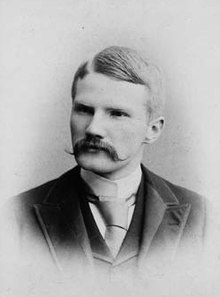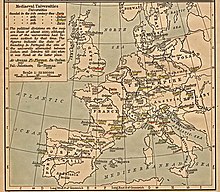High medieval "Renaissance"
The renaissance of the 12th century was a period of the High Middle Ages that was marked by great changes of a social, political and economic nature. This was accompanied by an intellectual revival of Europe rooted in philosophy and science. These changes paved the way for the real Renaissance , which began in Italy during the 14th century .
Concept history

The medievalist Charles Homer Haskins was the first historian to write in detail about a “renaissance” that began around 1070 and heralded the high Middle Ages. In 1927 he wrote:
“The 12th century in Europe was in many respects an age of fresh and vigorous life. The epoch of the Crusades, of the rise of towns, and of the earliest bureaucratic states of the West, it saw the culmination of Romanesque art and the beginnings of Gothic; the emergence of the vernacular literatures; the revival of the Latin classics and of Latin poetry and Roman law; the recovery of Greek science, with its Arabic additions, and of much of Greek philosophy; and the origin of the first European universities. The twelfth century left its signature on higher education, on the scholastic philosophy, on European systems of law, on architecture and sculpture, on the liturgical drama, on Latin and vernacular poetry [...] "
“The 12th century in Europe was in many ways a prosperous and vibrant age. During this epoch of the Crusades , the rise of the cities and the first states of the West, fell the height of the Romanesque , the beginnings of the Gothic , the spread of vernacular literature, the revival of the Latin classics, poetry and Roman law, and the return to Greek science with its Arabic additions as well as a large part of Greek philosophy and the emergence of the first European universities . The 12th century shaped higher education, scholasticism , European legal systems, architecture , sculpture , liturgical play , Latin and vernacular poetry [...] "
The 12th century renaissance
economy

In Northern Europe, developed in the 12th century after the founding of Lübeck the Association of Cities of Düdeschen Hanse . Many cities within the Holy Roman Empire such as Hamburg , Stettin , Bremen and Rostock , but also outside such as Wisby (Gotland) and Reval (Estonia) became Hanseatic cities . At the same time, the Germans began to settle in the east , which later became Prussia and Silesia .
In southern Europe, the Italian maritime republics of Venice , Genoa and Pisa were the prominent trading powers. B. Marseille ( Provence ) or Barcelona ( Principality of Catalonia ) also profited from the Levant trade .
The spread of the banking system is mainly connected with the money economy of the " Lombards ". The fairs in Champagne and the cities in Flanders were important commodity and financial markets . Bruges in particular became the “pile of Christianity”.
science
The philosophical and scientific teachings of the early Middle Ages were essentially based on a few copies of ancient Greek texts and commentaries that had survived in Western Europe after the collapse of the Western Roman Empire . Europe had largely lost touch with the knowledge of antiquity . This changed during the 12th century Renaissance. The increasing contact with the Islamic world in Andalusia and Sicily as well as through the Crusades and Reconquista on the one hand, with Byzantium on the other hand, also gave Europeans access to the works of Greek and Arab philosophers and scientists such as Aristotle, Euclid, Ptolemy, Plotinus , Avicenna and others. The emergence of universities encouraged the translation and dissemination of these texts.
By the beginning of the 13th century, there were fairly accurate Latin translations of the most important works of almost all of the great authors of antiquity. This resulted in a reliable exchange of scientific ideas, which was carried out by both universities and monasteries. At this point in time scholastics such as Robert Grosseteste , Roger Bacon , Albertus Magnus and Duns Scotus expanded the scientific knowledge of these texts. The most extensive use of mathematics as a way of understanding nature can already be seen as a forerunner of scientific methodology .
literature
- Haskins, Charles Homer. The Renaissance of the Twelfth Century . Cambridge: Harvard University Press, 1927.
swell
- ^ Charles Homer Haskins: The Renaissance of the Twelfth Century . Cambridge: Harvard University Press, 1927, p. viii.
- ^ Concise dictionary of economics. Volume 9, 1977, p. 71
- ↑ The circle in this 13th century manuscript is a symbol of the divine act of creation. See Thomas Woods, How the Catholic Church Built Western Civilization . Regnery, Washington 2005, ISBN 0-89526-038-7 , pp. 75-76.


